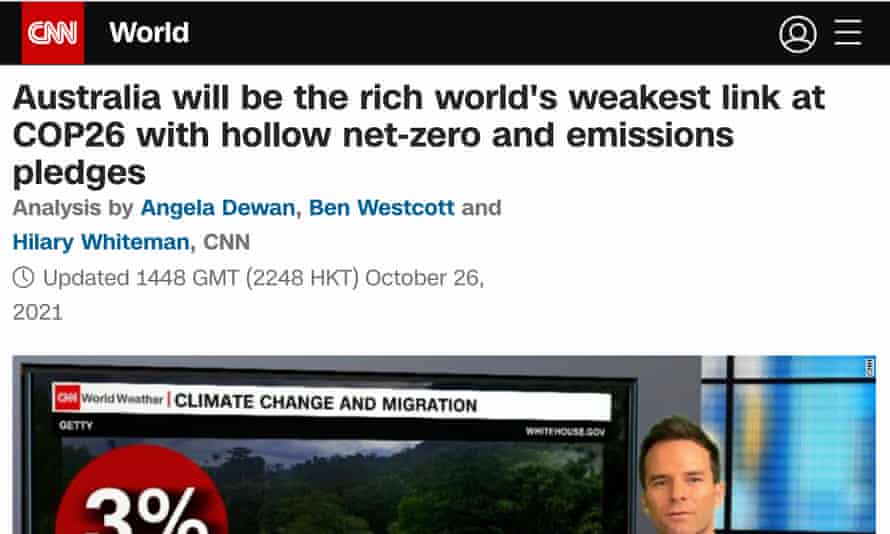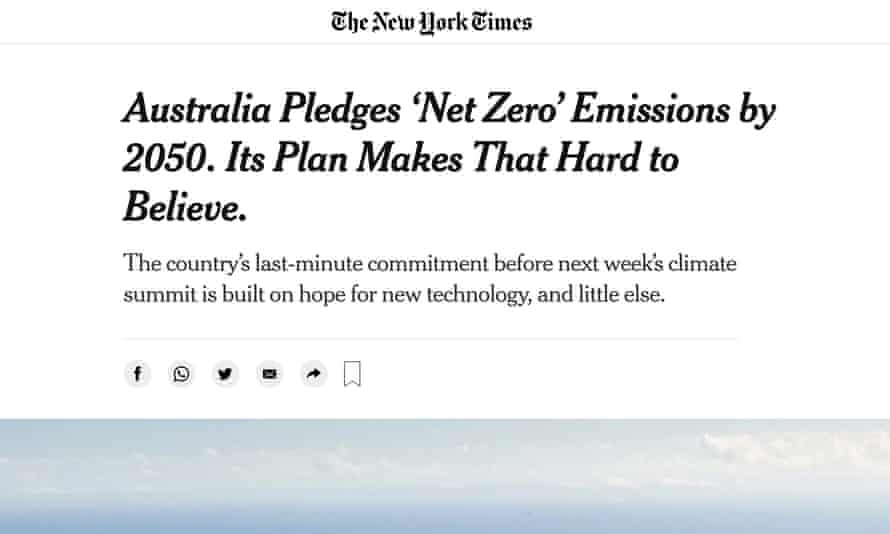What scrutiny? Apart from a slogan, there was no detail to review and for the most part dismissed at COP26. Read the following:
https://www.theguardian.com/environment/2021/oct/27/hollow-how-the-morrison-governments-2050-net-zero-pledge-was-reported-internationallyThe Australian government’s net zero by 2050 plan has been met with scepticism overseas, with major international media organisations labelling Scott Morrison’s announcement this week “hollow” and “hard to believe”.
Some of the harshest criticism came from CNN, which labelled Australia “the rich world’s weakest link at Cop26”. The broadcaster contrasted the Morrison government’s “defiant” climate plan against the US, UK and EU’s efforts to legislate net zero and cut greenhouse gas emissions.
“It should be a moment to celebrate,” CNN’s analysis stated. “But in reality, Morrison will go to Cop26, reluctantly, with the weakest climate plan among the G20’s developed nations.”
Photograph: CNNThe BBC’s coverage was also cynical of how Australia – as a “massive exporter” of fossil fuels with “some of the highest emissions per head of population” – has “long dragged its heels on climate action”.
Morrison’s promise to “strike a balance” between investing in low-emissions technologies, avoiding climate tax, maintaining the coal industry, while still reaching net zero by 2050, was received with scepticism by the British broadcaster’s Australia correspondent, Shaimaa Khalil.
“While this is a big moment for Australia, the details are still murky and potentially problematic on how net zero will be achieved,” she wrote.
VERY late to the party, with just days ahead of #COP26 - #Australia finally committing to #NetZero emissions by 2050. A big announcement with very little detail. My analysis included in the piece below. #auspolhttps://t.co/H9MeWmE4kv
— shaimaa khalil BBC (@Shaimaakhalil) October 26, 2021The New York Times reported Morrison’s proclamation of the “Australian way” to achieve net zero sounded “like he was already campaigning” for next year’s federal election.
The New York Times also noted Morrison did not mention the devastating risk of temperatures continuing on their current trajectory, “which is what world leaders who have made more ambitious commitments are seeking to avoid”.
The newspaper reported that Australia is already “increasingly vulnerable” to global warming, noting that recent severe fires, droughts, cyclones and the nation’s surface temperature warming by 1.4C since 1910 were not part of Morrison’s Tuesday address.
Photograph: New York TimesThe Washington Post similarly raised the devastating bushfires of early 2020, and the urgent push for action against global warming that followed.
The paper quoted climate experts who said the government was “kicking the can down the road” and that the plan “would do little to change the international perception of Australia as a climate laggard.”
https://www.newcastleherald.com.au/story/7484005/pm-unveils-australias-2050-net-zero-plan/
" ... Australia has pinned its hopes on existing technologies and unproven breakthroughs to achieve a 2050net-zero carbon emissions target.
Mr Morrison on Tuesday revealed the government's plan to reach 2050 carbon neutrality relies on existing policies. ..."
How does that work? Morrison actively campaigned in 2019 on a platform best described in the following article.
https://www.theguardian.com/australia-news/2021/apr/24/global-reset-on-climate-action-leaves-scott-morrison-looking-like-yesterdays-man"... The Coalition has been telling voters in the regions for more than a decade that climate action will steal their jobs and their four wheel drives and “wipe out” their towns.
This is the core of the Coalition’s cynical weaponisation of climate policy, the pitch that helped Morrison hold Queensland, and therefore government, in 2019.
But this week, suddenly, without warning, the transition to low emissions wasn’t an apocalypse. It was opportunity, and opportunity in exactly the same places the Coalition sold the apocalypse in 2019. The coming transition was a boon for Whyalla and Gladstone and the Pilbara, and a marginal seat on the Central Coast of New South Wales that may, or may not, depending on a process of grants allocations yet to be determined, become one of Australia’s new “hydrogen valleys” – like Silicon Valley, but with electrolysis.
This benign transition, the one that turned up this week, would preserve all jobs, and was “an exciting challenge” Australia would solve. Given that all the technological options the government is currently framing as champions of the “good” transition (hydrogen, carbon capture and storage) existed at the time of the 2019 election – it’s almost like one of the parties of government in Australia has been having a giant lend at our expense. Imagine that. Who knew?
- Forums
- Political Debate
- Labor vaguery costed but detail not provided.
The New York Times reported Morrison’s proclamation of the...
-
- There are more pages in this discussion • 3 more messages in this thread...
You’re viewing a single post only. To view the entire thread just sign in or Join Now (FREE)






